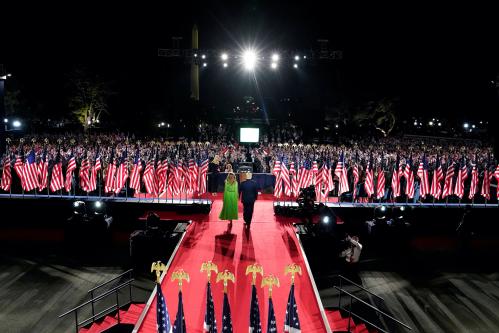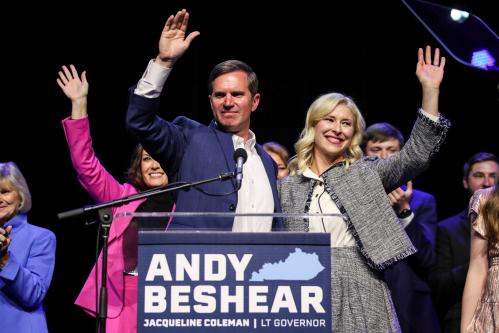With Supreme Court Justice Ruth Bader Ginsburg’s death less than two months before the presidential election it has been impossible, even in the midst of mourning, to avoid wondering what impact the sudden vacancy will have on the election.
I think the answer is either very little impact or none at all. I say that not because the consequences of President Trump filling this vacancy are minor—they are not. Part of the reason it’s so consequential is that the nation has lost a great fighter for women’s rights. I say it because this year has been filled with unimaginable drama, none of which has managed to alter the overall shape of the race.
Have a look at the following graphic from RealClearPolitics. It shows the average of polls matching Biden against Trump. The data begins on February 1, when many in the political establishment thought Joe Biden was toast. He didn’t win one of that month’s contests until South Carolina on February 29, but he was still polling ahead of Donald Trump. In March Biden was ahead of Trump both before and after America began shutting down over the coronavirus, and as his path to locking up the nomination began in earnest. At the end of May he was ahead of Trump both before and after the killing of George Floyd. As the summer wore on and Black Lives Matter protests moved from one city to another, at times becoming violent, he was ahead of Trump. When the nominating conventions—largely virtual this year—opened and closed he was ahead of Trump. On September 22 he was 6.6% points ahead of Trump—only a 1.2% difference from the February 1 polls where he ran ahead of Trump by 5.4%

Source: RealClearPolitics
This presidential race has been steady during eight very dramatic months for one reason. In almost all democracies, when the head of state or government is up for re-election, the election is about them. It’s that simple. And if the judgment on the leader’s performance is negative, the only hope the incumbent has is to make the opponent out to be less palatable. Trump has tried to do this but so far Sleepy Joe, Joe Biden the socialist, Joe Biden Trojan horse for the radical left, and Joe Biden the father of Hunter Biden have all failed to displace America’s view of Uncle Joe, Obama’s dutiful VP.
Of course, the caveat to all this is that we don’t elect a president nationally, we elect him at the state level in the Electoral College. As we’ve seen twice already in this century, things there can go seriously awry. For the coming fight around the Supreme Court vacancy to matter it will have to have a differential effect on one of the groups in the electorate—and the most important group is shaping up to be suburban voters, especially women.
In 2016, the suburbs constituted 49% of the overall vote with rural areas and urban areas each trailing behind. Hillary Clinton swept urban areas and Trump swept rural areas, so the race boiled down to the suburbs where Donald Trump beat Hillary Clinton by 4 percentage points, 49% to 45%. In contrast, in 2018 suburban voters—especially suburban women—were the key to Democratic victories in the House. So, this year Biden needs to hold on to those voters and Trump needs to win some of them back in key states.
What is the state of the race in the suburbs? Until recently, the news for Trump has not been good. An NPR/PBS NewsHour/Marist Poll has suburban voters breaking 60% to 35% for Biden.
But that’s a national poll. What really matters are the suburban voters in swing states. For instance, in the critical state of Wisconsin, the Milwaukee suburbs seem to be tilting towards Trump. But in the equally critical state of Pennsylvania, the Philadelphia suburbs seem to be moving towards Biden.
So, the question of impact boils down to this: if the coming fight over the Supreme Court is going to affect the election, it will affect it by changing the mobilization of women voters in the suburbs. In some places it might help bring voters back to Trump, helping him win narrow victories in key states. In other places it might energize even more voters to vote for Biden. With the Supreme Court in play, abortion rights are front and center. But support for and opposition to legal abortion is so baked into our partisan preferences that it may not make much of a difference in the election. Overall support for legal abortion has been stable and high, 61%, for nearly a quarter of a century. And this holds for the suburbs as well. Suburban voters aren’t much different than urban voters in their support for legal abortion (59% support, 39% oppose).
There are other big issues before the Court: the future of Obamacare, voting rights and LGBTQ rights, to name a few. All of these issues will mobilize voters in what is shaping up to be one of the most intense elections in our lifetime. It is not at all clear that the fight over the Supreme Court vacancy, consequential as it is for our future, will be as consequential in November.







Commentary
What impact will the death of Ruth Bader Ginsburg have on the 2020 Election?
September 23, 2020